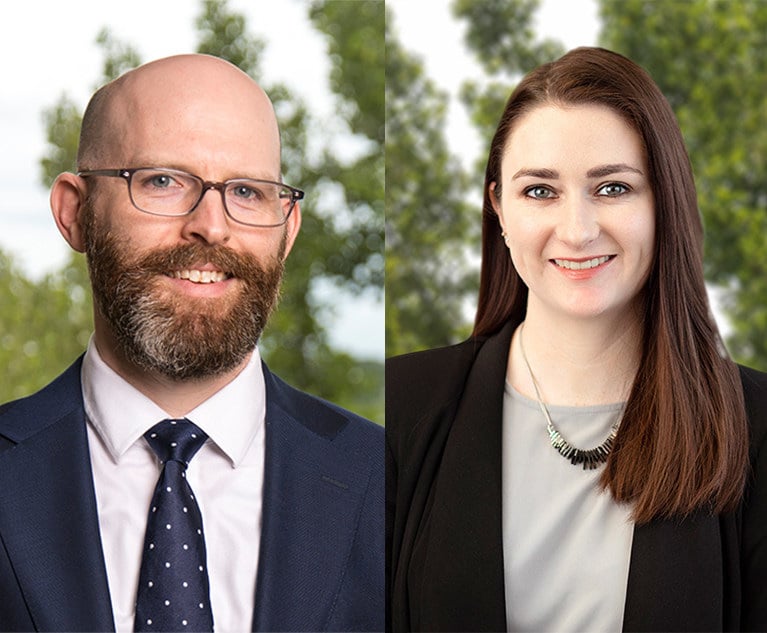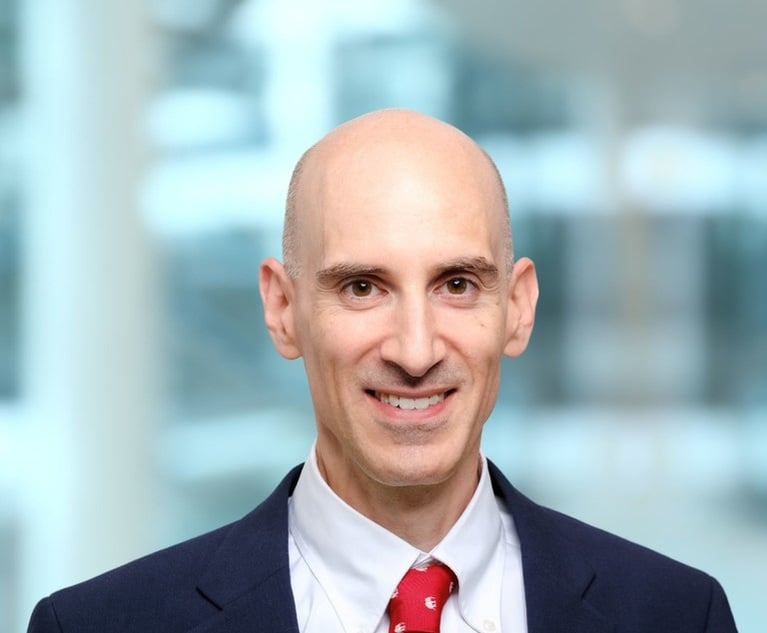An Update on Lawyers' Duty of Technological Competence: Part 2
Continuing a discussion they started in an earlier article, Professional Responsibility columnists Anthony Davis and Steven Puiszis discuss additional areas that require technological competence: social media; electronic discovery; technology used by clients to build products or offer services, and technology used to present information in court.
May 03, 2019 at 12:00 PM
11 minute read

This is the second article in this column addressing the meaning and implications of Comment 8 to New York Rules of Professional Conduct 1.1, which states that “To maintain the requisite knowledge and skill, a lawyer should … (ii) keep abreast of the benefits and risks associated with technology the lawyer uses to provide services to clients or to store or transmit confidential information.”
In the first column published on March 1, 2019, we discussed the first two areas of technological competence reasonably necessary for today's lawyers: data security and the technology used to practice law. In this article we address four other areas that require technological competence: social media; electronic discovery; technology used by clients to build products or offer services; and technology used to present information in court.
Social Media Competence
Lawyers who are social media users need to understand how these activities have huge ethical and legal implications.
Social media posts or communications have no geographic borders, may be searched and found indefinitely and by anyone. The most basic difficulty lawyers face in this regard is that there are subtle yet potentially significant variations in various states' Rules of Professional Conduct as to what is, or is not permissible use of social media.
Ethics opinions have addressed an array of issues in connection with social media usage, including: preserving confidentiality; compliance with the advertising and solicitation rules; creating unintended attorney-client relationships; using social media to investigate parties, witnesses and jurors; and the permissible scope of a lawyer's advice concerning a client's social media information.
The duty of competence applies to lawyers' decisions to use social media. Lawyers who use a social media network in their practice need to review the terms and conditions, including privacy features—which change frequently—prior to using the network. See, e.g., ABA Comm. on Ethics & Profl. Responsibility, Formal Op. 466 (2014), and D.C. Bar Legal Ethics Comm., Ethics Op. 370 (2016).
The use of social media triggers several distinct risks to client information. First, confidential client information may be disclosed in violation of Rule 1.6. Accordingly, many law firms have developed social media policies that prohibit the disclosure of any information relating to a firm matter or to the legal services provided to current or former clients of the firm without express client consent. Additionally, lawyers who blog or who are active on social media need to run conflict checks before blogging or tweeting about an actual case because the lawyer's firm may represent one of the parties.
Even in the face of a negative on-line review by a current or, more often, former client, lawyers have an obligation to preserve client confidences. All of the ethics opinions that have addressed this situation have concluded that responding to a negative online review does not trigger the exception to Rule 1.6 that, in other circumstances, permits lawyers to reveal confidential information to establish a defense to a controversy between the lawyer and a client, or to respond to allegations in any proceeding concerning the lawyer's representation of the client. See, e.g., Pa Bar Assoc., formal Op. 2014-300 (2014).
When lawyers use social media such as LinkedIn to develop business, the advertising and solicitation rules apply. Although a lawyer's social media profile that merely provides biographical information and the lawyer's current and past employment does not constitute attorney advertising, the ethics opinions differ as to whether statements including a detailed description of practice areas and types of work done in prior employment requires the user to include the words “Attorney Advertising” on the lawyer's…profile. Similarly, lawyers bragging about outcomes achieved for their clients may need to comply with the requirements of a disclaimer that “prior results do not guarantee a similar outcome.”
Some social media sites permit third parties to add an endorsement or recommendation to a lawyer's profile. Attorneys have an obligation to monitor those to ensure they are not false or misleading, and to remove or correct any endorsement or recommendation that is misleading or inaccurate.
When lawyers answer questions posed on a lawyer's personal account or a law firm's social media site, they can safely provide a general answer to general legal issues or questions, but when they provide specific legal advice to a specific problem they run the risk of unintentionally creating an attorney-client relationship, or at least triggering a belief in the mind of the party asking the question that such a relationship exists.
Although lawyers may view the public profile, public portion, or the public posts of a party or a witness on any social media account, ethics opinions preclude sending a request to view the private portion of a social media account of a party, or any witness whom the lawyer knows is represented by counsel. Numerous ethics opinions also prohibit the use of deception when contacting a witness either directly by the lawyer or indirectly through an investigator, paralegal or third party to seek private social media information. See, e.g., N.Y. City Bar Assoc., Formal Op. 2010-2 (2010).
While lawyers may send a request to view the private portion of an unrepresented person's social media account (a “friend” request), the ethics opinions are split as to what information a lawyer must include in such a request to avoid it being deceptive. In New York, a lawyer who uses his or her real name and profile does not need to disclose the reason for making the request (N.Y. City Bar Assoc., Formal Op. 2010-2 (2010)), but other states' opinions advise lawyers to disclose they are a lawyer for a party (see, e.g., Mass. Bar Assoc., Advisory Op. 2014-5 (2014)), or their involvement in a disputed or litigated matter (see, e.g., N.H. Bar Assoc. Ethics Op. 2012-13/05), or the “lawyer's affiliation and purpose for the request.” See, e.g., San Diego County Bar Assoc., Formal Op. 2011-2 (2011).
Because the rules governing a lawyer's conduct in connection with litigation will usually be the rules of the jurisdiction of the court where the litigation is taking place, New York lawyers should take note of the need to review the applicable ethics opinions on this issue in that jurisdiction rather than rely on the New York opinion.
Outside New York, the same rules generally apply to jurors; lawyers are permitted to view the public information posted on a juror or a prospective juror's social media account unless otherwise prohibited by law or a court order. But lawyers may not send a request to view the private areas of a juror's social media account or profile, since that would constitute an ex parte communication with a juror. See, e.g., ABA Formal Op. No. 466 (2014).
However, the New York City Bar Association has opined that the fact that some social media networks automatically alert a person that their profile has been viewed constitutes an impermissible contact with a juror. See N.Y. City Bar Assoc., Formal Op. 2012-2 (2012). So New York practitioners should determine which social media networks generate these types of messages before even viewing the public social media postings of jurors or prospective jurors.
Finally, while lawyers may advise clients about taking down social media information, it is critically important that lawyers also instruct clients, in writing, to preserve any and all information that is taken down, in case a question later arises as to the relevancy of the information to a contested matter. Nothing, however, prohibits a lawyer from advising a client to change the client's privacy or security settings on any social media account, or from making publically available information private, so long as it is properly preserved.
Electronic Discovery
It is axiomatic today that at the outset of any case, and in order to provide competent representation, a lawyer should assess what electronic discovery issues might arise during the litigation and his or her own e-discovery skill, and if those skills are lacking lawyers must either acquire sufficient learning or skill, or associate or consult with someone with the necessary expertise to assist. The by now accepted basic technological competence required to make appropriate decisions in connection with e-discovery includes the necessary know-how to:
• Initially assess e-discovery needs and issues, if any;
• Implement/cause to implement appropriate electronically stored information (ESI) preservation procedures;
• Analyze and understand a client's ESI systems and storage;
• Advise the client on available options for collection and preservation of ESI;
• Identify custodians of potentially relevant ESI;
• Engage in competent and meaningful meet and confer with opposing counsel concerning an e-discovery plan;
• Perform data searches;
• Collect responsive ESI in a manner that preserves the integrity of that ESI; and
• Produce responsive non-privileged ESI in a recognized and appropriate manner.
But today, in the new universe of artificial intelligence (AI), discussed in the previous article, lawyers need to be well versed, and able to advise clients in the selection of appropriate predictive coding software in order to improve the accuracy and speed of electronic discovery and minimize its cost.
Importantly, consultation or collaboration with an expert in any of these processes does not absolve an attorney of her duty to supervise the work of any attorney, expert, vendor or client assisting the attorney. That duty is non-delegable, and the attorney retains overall responsibility for the work of the expert, even if the expert is someone selected or employed by the client.
Competence in Dealing With Client-Developed Technology
In order to give competent legal advice, lawyers always need to understand the technology used by clients to design and manufacture the products they sell or use in the transactions the lawyers work on, or in the cases they litigate. Today, in addition to understanding how AI software works, common technologies developed or operated by clients can run the gamut from robotics and 3D printing to the use of drones, autonomous vehicles, nano technology or coding used in software components and anything in between.
Technology has impacted both the design and manufacture of products. Technology is changing so rapidly that the issues lawyers will be asked to understand and address, such as DNA identification or autonomous vehicles, will be radically different from those faced in the past. As was recognized in Cal. State Bar, Form Op. 2015-193, 3 (2015), “[l]egal rules and procedure, when placed alongside ever-changing technology, produce professional challenges that attorneys must meet to remain competent.”
Competence in the Courtroom
Trial lawyers face a variety of challenges if they are to become technologically competent in the courtroom. First, they must be familiar with the new methods available to present information and rules governing the authentication and admissibility of new and emerging technological evidence. As one example, annotation monitors that allow witnesses to mark electronic exhibits, and evidence cameras that convert paper documents into electronic exhibits to display to a jury are making their way into courtrooms. Skills in using white boards and PowerPoint are not the cutting edge of competence in today's courtroom presentations.
Second, trial lawyers need to be aware of how technology offers new ways to develop evidence. Fitness trackers, “wearables” and social media are becoming fruitful sources of information that can corroborate or devastate injury claims. Google Glass has been used to create day-in-the-life videos of traumatically injured individuals. GPS tracking and electronic control modules (“black boxes”) in motor vehicles can provide detailed and accurate information about location, velocity, speed, acceleration and deceleration rates critical to many disputes. Drones can be used to monitor and track movements of vehicles and persons or the progress of high-rise construction projects. Technological competence requires that lawyers understand not only what technology is available to help establish their case, but how to use it effectively.
Anthony E. Davis and Steven M. Puiszis are partners of Hinshaw & Culbertson. Anthony E. Davis is a past president of the Association of Professional Responsibility Lawyers. Steven M. Puiszis is Hinshaw's General Counsel—Privacy, Security & Compliance.
This content has been archived. It is available through our partners, LexisNexis® and Bloomberg Law.
To view this content, please continue to their sites.
Not a Lexis Subscriber?
Subscribe Now
Not a Bloomberg Law Subscriber?
Subscribe Now
NOT FOR REPRINT
© 2025 ALM Global, LLC, All Rights Reserved. Request academic re-use from www.copyright.com. All other uses, submit a request to [email protected]. For more information visit Asset & Logo Licensing.
You Might Like
View All
Don’t Blow It: 10 Lessons From 10 Years of Nonprofit Whistleblower Policies
9 minute read
Fusion Voting and Its Impact on the Upcoming Election
Trending Stories
- 1Uber Files RICO Suit Against Plaintiff-Side Firms Alleging Fraudulent Injury Claims
- 2The Law Firm Disrupted: Scrutinizing the Elephant More Than the Mouse
- 3Inherent Diminished Value Damages Unavailable to 3rd-Party Claimants, Court Says
- 4Pa. Defense Firm Sued by Client Over Ex-Eagles Player's $43.5M Med Mal Win
- 5Losses Mount at Morris Manning, but Departing Ex-Chair Stays Bullish About His Old Firm's Future
Who Got The Work
J. Brugh Lower of Gibbons has entered an appearance for industrial equipment supplier Devco Corporation in a pending trademark infringement lawsuit. The suit, accusing the defendant of selling knock-off Graco products, was filed Dec. 18 in New Jersey District Court by Rivkin Radler on behalf of Graco Inc. and Graco Minnesota. The case, assigned to U.S. District Judge Zahid N. Quraishi, is 3:24-cv-11294, Graco Inc. et al v. Devco Corporation.
Who Got The Work
Rebecca Maller-Stein and Kent A. Yalowitz of Arnold & Porter Kaye Scholer have entered their appearances for Hanaco Venture Capital and its executives, Lior Prosor and David Frankel, in a pending securities lawsuit. The action, filed on Dec. 24 in New York Southern District Court by Zell, Aron & Co. on behalf of Goldeneye Advisors, accuses the defendants of negligently and fraudulently managing the plaintiff's $1 million investment. The case, assigned to U.S. District Judge Vernon S. Broderick, is 1:24-cv-09918, Goldeneye Advisors, LLC v. Hanaco Venture Capital, Ltd. et al.
Who Got The Work
Attorneys from A&O Shearman has stepped in as defense counsel for Toronto-Dominion Bank and other defendants in a pending securities class action. The suit, filed Dec. 11 in New York Southern District Court by Bleichmar Fonti & Auld, accuses the defendants of concealing the bank's 'pervasive' deficiencies in regards to its compliance with the Bank Secrecy Act and the quality of its anti-money laundering controls. The case, assigned to U.S. District Judge Arun Subramanian, is 1:24-cv-09445, Gonzalez v. The Toronto-Dominion Bank et al.
Who Got The Work
Crown Castle International, a Pennsylvania company providing shared communications infrastructure, has turned to Luke D. Wolf of Gordon Rees Scully Mansukhani to fend off a pending breach-of-contract lawsuit. The court action, filed Nov. 25 in Michigan Eastern District Court by Hooper Hathaway PC on behalf of The Town Residences LLC, accuses Crown Castle of failing to transfer approximately $30,000 in utility payments from T-Mobile in breach of a roof-top lease and assignment agreement. The case, assigned to U.S. District Judge Susan K. Declercq, is 2:24-cv-13131, The Town Residences LLC v. T-Mobile US, Inc. et al.
Who Got The Work
Wilfred P. Coronato and Daniel M. Schwartz of McCarter & English have stepped in as defense counsel to Electrolux Home Products Inc. in a pending product liability lawsuit. The court action, filed Nov. 26 in New York Eastern District Court by Poulos Lopiccolo PC and Nagel Rice LLP on behalf of David Stern, alleges that the defendant's refrigerators’ drawers and shelving repeatedly break and fall apart within months after purchase. The case, assigned to U.S. District Judge Joan M. Azrack, is 2:24-cv-08204, Stern v. Electrolux Home Products, Inc.
Featured Firms
Law Offices of Gary Martin Hays & Associates, P.C.
(470) 294-1674
Law Offices of Mark E. Salomone
(857) 444-6468
Smith & Hassler
(713) 739-1250








